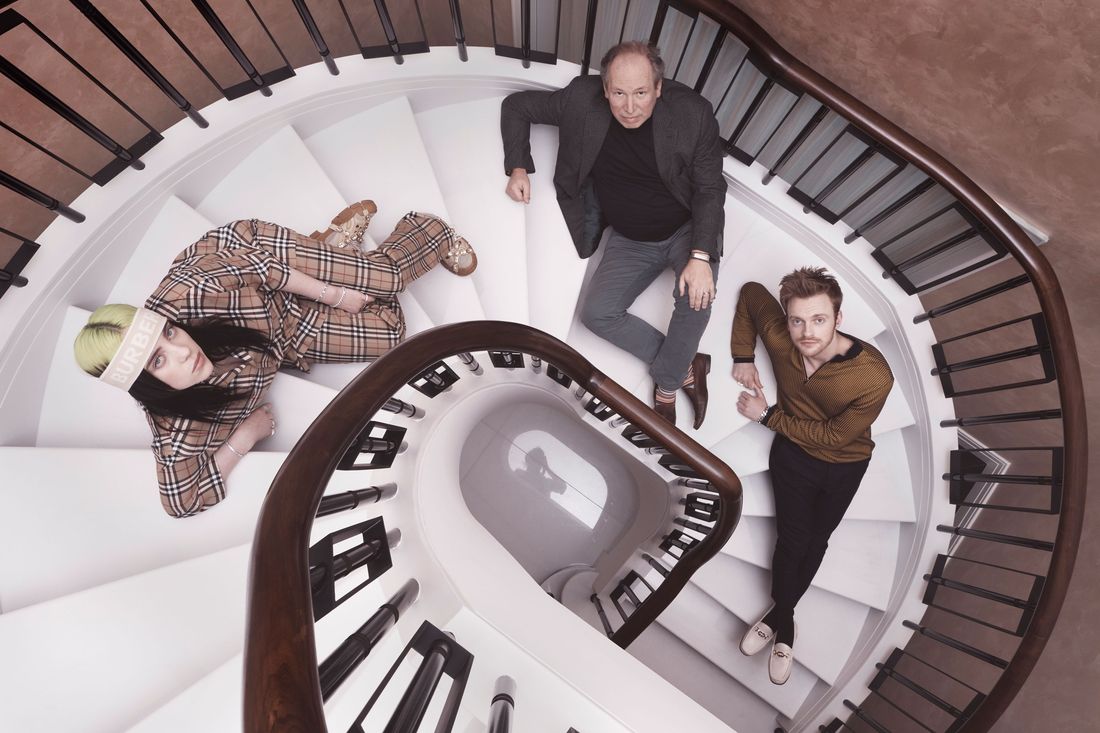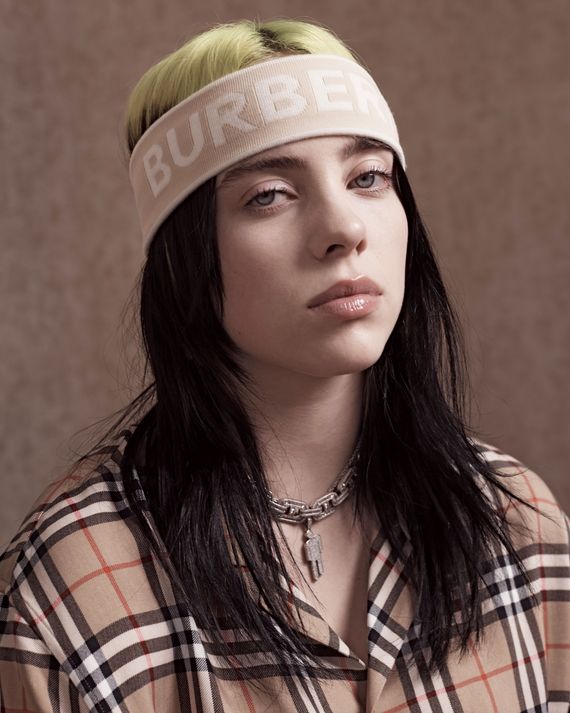
Vulture is recirculating this piece in celebration of the new James Bond film No Time to Die’s long-awaited release in theaters this Friday. The theme “No Time to Die” won a Grammy in March.
Billie Eilish built a blockbuster in a bedroom, so it makes sense she’d record a Bond song on a tour bus. “We recorded the vocals in a bunk in the dark on the bus in a basement in Texas,” she recalls of the creation of “No Time to Die,” her song for the James Bond film of the same name, set to be released later this year. “It was pitch black. No movement. I was just, literally, holding a mic.”
This is nothing new for Eilish, 18, and her older brother, Finneas, 22, who recorded her 2019 debut, When We All Fall Asleep, Where Do We Go?, in their parents’ Southern California home. The album netted billions of streams and almost as many Grammys and cemented Eilish as a generation-defining pop act. So when the duo tackled the particular cultural institution of the James Bond theme, they again sought intimate settings. The result is a big, big ballad. For all her outward signifiers of Gen-Z genre clash, Eilish proves herself to be a throwback powerhouse vocalist on the track.
She’ll need that power, too. Not long after the song came out, concerns about the coronavirus prompted the producers of No Time to Die to delay the film’s release until November. (It was originally set to open worldwide in April.) That means that Eilish’s track will be out there, by itself, for months, a theme song to a movie nobody can see just yet.
As she explains the process behind the song, Eilish is sitting on a couch in a cloistered London hotel penthouse. (Before gaining access to the correct exclusive elevator, I was checked by three separate, stiffly smiling members of the staff.) She is flanked by the endearingly polite Finneas and the endearingly excitable Hans Zimmer, 62, the iconic soundtrack composer (Thelma & Louise, Inception, the Dark Knight trilogy) who wrote the film’s score and added string orchestration to “No Time to Die.” She is in Burberry to the headband.
Her brother picks up the story: They were on tour this past October, somewhere in Texas, right before a show. Dallas? Houston? He can’t quite recall. They were on a parked tour bus in the lower levels of an echoey arena. If you isolate the vocals, Finneas says, “you can hear a lot of, like, vacuums in the background.” With the kind of year they’re having, it was the only place they could carve out the time to work.
“We’d been telling our team for years that we want to do something with Bond,” says Eilish. It’s funny to think about an 18-year-old wanting anything “for years”; it’s especially surprising to hear this particular young ingénue say she was drawn to a tradition-bound franchise. But Eilish’s aesthetics have always been a bit more subversive than her music. As the Times put it, cutting a Bond theme is a “Boomer-approved role” that Billie has “embraced with the most straightforward enthusiasm.”
As No Time to Die was still being shot, the duo met with Bond producer Barbara Broccoli after a show in Dublin. Broccoli had flown out specifically for the occasion; she was quickly charmed. They were given parts of the script and went about the business of creating a theme.
Finneas had originally tried to compose it on guitar, but, Eilish says diplomatically, “it … did not work. And we actually had pretty bad writer’s block.” Then Finneas ditched his guitar and located a piano in the green room of that anonymous Texas arena and played a little riff. “It’s the first thing you hear in the song,” Eilish says. “Immediately we were like, ‘Ohhhh.’ It just suddenly made sense. And then we wrote the rest.”
From there, it went off for approval to Zimmer in L.A., who had already been offered a small suite of options from several artists. “I’m not going to say who” the other acts were, Zimmer says, “but I am going to get myself into loads of trouble, and I don’t care: I couldn’t get past the intro” of the other tracks. But when he heard Eilish and Finneas’s offering, he knew it was the one: “That’s the vibe. That’s the everything. It’s a perfect movie song: In its quietness, somehow, you have a huge landscape in front of you.”
The trio eventually convened in person for a few days of recording with a 70-person orchestra at George Martin’s air Studios in London, now housed in a gorgeous, acoustically pristine Victorian-era church.
“We experimented around,” says Zimmer.
“We experimented for a while,” Eilish says.
“We experimented with 70 people,” Zimmer says, laughing.
With Billie and Finneas’s input, Zimmer eventually assembled two wholly different string arrangements for the song. The new pals also took some time to mess around. “My favorite moment of the whole weekend that we spent in London with Hans was Billie and Hans playing a duet together on the piano, improvisationally, during the setup of air Studios,” Finneas says. “Microphones were being moved around. Sheet music was being shuffled.”
Throughout the day of our interview, Eilish has shown an occasional weariness with the pressures of the job. At one point, a photographer asks for a certain performative pose and she huffs back, in full angsty teen glory: “Can we just do normal stuff?” At another, she leans back on the couch with her phone and rests her massive Gucci Flashtrek sneakers on Finneas’s lap. (A dutiful big brother, he doesn’t shove her feet off.) Later, I ask her a question relating to a conversation that’s been rolling on in the room for a few minutes, about whether they might ever collaborate directly with movie directors the way Zimmer does. She looks at me blankly, then admits, “I—wasn’t listening for the last five minutes.”
But when that anecdote about her and Zimmer and the piano comes up, she quickly pulls up the video on her phone and gleefully shows it to the room: the two of them, just playing random riffs. “Isn’t that cute?! It just went on and on!,” she says.
After strings were added to the track, Zimmer made sure that Eilish and Finneas got to see a full rough cut of the film. That, in turn, led them to add one last piece to the song: that swing Eilish takes at the end, that big kick into “No time to diiiyyyeeee.”
Zimmer: “It was after you saw the film. It sort of allowed you to be let off the leash.”
Finneas: “Once we had a beautiful orchestra beneath [us], Billie was compelled—”
She cuts him off. “It had to go somewhere. I had to do it.”
The collaboration didn’t end there. As Zimmer continued to work on the score, he solicited their advice. He would send pieces of music, then ask for input: variations, tweaks, suggestions. “I would text Finneas, ‘Can I just get a little da-da-da whatever?’ ”
“It’s been really fun,” says Eilish. “He’s just like, ‘Can we get a little this?’ And we immediately record and send it to him.”
“In a funny way, our styles are not that dissimilar,” Zimmer continues. “You record at home. I record four floors down in my house” (i.e., in an apartment converted into a makeshift studio in his Santa Monica complex). “So the whole score is homemade.”
Finneas nods. “I think wherever is close enough to your bed so you’re tricked into thinking it’s okay to stay up past your bedtime is the right place to record.”
Despite their age difference, Eilish, Finneas, and Zimmer have another thing in common: They’re all relative newcomers to the live stage. Billie and Finneas have been touring for about three years, since breaking out with the song “Ocean Eyes.” Zimmer has had a long and esteemed career behind the scenes, but only took to touring four years ago. “I have to name-drop,” Zimmer says by way of explanation. “Johnny, my best friend, was the one who changed my life.” He means Johnny Marr from the Smiths, whom Zimmer also enlisted for guitar work on “No Time to Die.” “Him and Pharrell sat me down one day and went, ‘You’ve got to stop hiding behind a screen. You have to do things in real time. You have to look an audience in the eye.’” Since then, Zimmer has done elaborate full orchestra performances of his movie scores all over the world.
I ask Billie and Finneas, who themselves have filled arenas and headlined festivals, if they’d traded tips with Zimmer about life on the road. Finneas laughs at the thought. “Oh, we don’t give Hans tips. We just ask for eternal wisdom.”
As the three chat, the conversation continuously moves away from the song to their shared life as professional musicians. Despite the age gap of decades, there’s a mutual respect that’s lovely to witness. “If I had done as many films as Hans, I might have a false sense of like, I can do anything,” Finneas says. “But I watched Hans’s MasterClass on the internet and I remember you said, ‘I’m convinced every time that I don’t know how to do it.’”
Zimmer nods happily. “We’re always starting with a blank page. And I check with myself every morning: Do I want to go to the studio? Do I want to go make music today? I slithered into this” — everyone cracks up.
“No, I applied for film composer!” Zimmer shouts, smiling. “Come on, I slithered into this. And I love it and I never want to lose the sense of loving it.”
Finneas picks up the thread. “After the Grammys, I jokingly said to my girlfriend, ‘If I didn’t love music so much, I’d quit.’ Because, yeah, we did the thing. But I love it, so let’s just keep going. We’ve started working on the new album, and I think the best thing we can do is stay out of our own way. The first album was pretty pure in its intention. We didn’t set out to write a darling album. Our only target was to make an album that we liked, to play live. I think that’s all we’re gonna do for the second. All the other things are side effects. You can’t aim for those.”
With that, he brings us back to “No Time to Die,” and how amazing it felt to get their tune picked by Hans Zimmer. “I totally respect this process,” Finneas says. “I admire it. Billie has had a really big year press wise. Our album did well, which is awesome. But I feel that we were only judged, in this case, on the song that we had written. On the merits of that.”
*A version of this article appears in the March 16, 2020, issue of New York Magazine. Subscribe Now!


